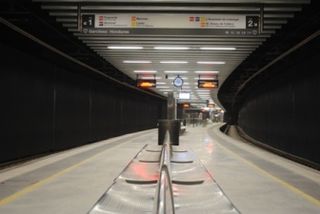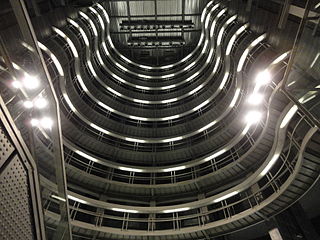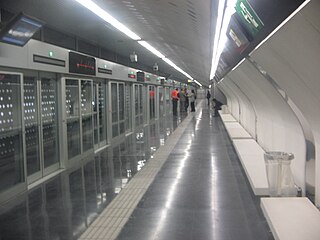
The Barcelona Metro is a network of rapid transit electrified railway lines that run mostly underground in central Barcelona and into the city's suburbs. It is part of the larger public transport system of Barcelona, the capital of Catalonia, Spain, with unified fares under the Autoritat del Transport Metropolità (ATM) scheme. As of 2014, the network is operated by two separate companies: Transports Metropolitans de Barcelona (TMB) and Ferrocarrils de la Generalitat de Catalunya (FGC). It is made up of 12 lines, combining the lines owned by the two companies. Two lines, L9 and L10, are being built at present, with both lines having different sections of each opened between 2009 and 2018. They are due to be fully completed in 2026. Three lines on the network have opened as automatic train operation/driverless vehicle systems since 2009: Line 11, Line 9 and Line 10, in chronological order.

Passeig de Gràcia ) is an underground railway and metro station in Barcelona located under Passeig de Gràcia, in Eixample district. It is one of the Barcelona's busiest railway stations and important stop for Barcelona Metro network. It is served by Rodalies de Catalunya suburban railway lines R2 and regional lines R11, R13, R14, R15 and R16, and it is also served by TMB-operated Barcelona Metro lines L2, L3 and L4.

Provença is the name of a Ferrocarrils de la Generalitat de Catalunya station located under Avinguda Diagonal and Balmes street. The station is served by FGC-operated Barcelona Metro lines L6 and L7, and Metro del Vallès suburban metro lines S1 and S2. Diagonal is the name of an important station in TMB-operated Barcelona Metro network. It is named after Avinguda Diagonal, where the station is located together with Passeig de Gràcia. It is served by TMB-operated Barcelona Metro lines L3 and L5, and it is also connected with FGC station.

Plaça d'Espanya, also simply known as Espanya, is an interchange complex underneath Plaça d'Espanya, in the Barcelona district of Sants-Montjuïc, in Catalonia, Spain. It comprises the Barcelona terminus of the Llobregat–Anoia Line and a Barcelona Metro station complex served by lines 1 (L1) and 3 (L3). On the L1, the station is between Hostafrancs and Rocafort, and on the L3 it is between Poble Sec and Tarragona. The Llobregat–Anoia Line station is served by Barcelona Metro line 8 (L8), Baix Llobregat Metro lines S33, S4 and S8, and commuter rail lines R5, R6, R50 and R60. The services on the Llobregat–Anoia Line are operated by Ferrocarrils de la Generalitat de Catalunya (FGC), whilst the L1 and L3 are operated by Transports Metropolitans de Barcelona (TMB).

Universitat is a Barcelona Metro station named after Plaça de la Universitat, split between Eixample and Ciutat Vella districts of Barcelona, where the station is located in. This square holds the historical building of Universitat de Barcelona, celebrated for its neo-gothic style. The station is accessible for disabled persons since 1995, when Barcelona Metro line 2 opened its platforms. It is served by TMB-operated Barcelona Metro lines L1 and L2.

La Sagrera-Meridiana, simply known as La Sagrera, is an interchange complex underneath Avinguda Meridiana, in the Barcelona district of Sant Andreu, in Catalonia, Spain. It consists of a Rodalies de Catalunya station and three Barcelona Metro stations. The Rodalies de Catalunya station is located in the Meridiana Tunnel on the Lleida to Barcelona via Manresa railway, between Sant Andreu Arenal and Arc de Triomf, and is operated by Renfe Operadora. It is served by Barcelona commuter rail service lines R3 and R4, as well as regional rail line R12. The Barcelona Metro stations are on lines 1 (L1) and 5 (L5), as well as the northern section of line 9/10, and are operated by Transports Metropolitans de Barcelona (TMB). On the L1, the station is between Navas and Fabra i Puig, on the L5 between Camp de l'Arpa and Congrés, and on the L9/L10 between Plaça Maragall (future) and Sagrera - TAV. The station is also projected to become the terminus of the L4 once the extension from La Pau opens. A number of interurban bus services stop near the station.

Line 10 is the name of one of the two branches of the Barcelona metro line 9, currently (2020) under construction and to be operated by TMB. Like Line 9 and Line 11, it will be an automatic train operation metro line.

Plaça de Catalunya station, also known as Barcelona-Plaça Catalunya, Plaça Catalunya or simply Catalunya is a major station complex in Barcelona located under Plaça de Catalunya, the city's central square and a large transport hub. Many Rodalies de Catalunya, Barcelona Metro and Ferrocarrils de la Generalitat de Catalunya lines go through it and many bus routes link it with all of the districts of the city and most of the municipalities in its metropolitan area.

Liceu is a Barcelona Metro station situated under the La Rambla between Gran Teatre del Liceu and Mercat de la Boqueria in the Barri Gòtic, part of Barcelona's district of Ciutat Vella. It is served by TMB-operated Barcelona Metro line L3.

Sarrià is a railway station located under the Via Augusta at Carrer de l'Hort de la Vila in the Sarrià neighbourhood of the Sarrià-Sant Gervasi district of Barcelona. It is served by lines L6 and L12 of the Barcelona Metro, and by lines S1 and S2 of the Metro del Vallès commuter rail system. All these lines are operated by Ferrocarrils de la Generalitat de Catalunya, who also run the station.

Gorg is a Barcelona Metro and Trambesòs complex named after the neighbourhood of the same name where the station is situated, in Badalona municipality. It is located on Avinguda del Marquès de Mont-Roig and very close to Palau Municipal d'Esports de Badalona, the home arena of the professional basketball club Joventut de Badalona. It is served by TMB-operated Barcelona Metro lines L2 and L10, and Trambesòs route T5.

La Rambla | Drassanes is a Barcelona Metro station located underneath Portal de la Santa Madrona, just off La Rambla in the Ciutat Vella district of Barcelona. It is named after the nearby Drassanes Reials de Barcelona, the old shipyards that are now the home of the Museu Marítim de Barcelona. It is the closest station to the Port of Barcelona and one of the network's closest stations to the sea, and is served by TMB-operated Barcelona Metro line L3.

Arc de Triomf is a Rodalies de Catalunya and Barcelona Metro interchange complex. It is named after the adjacent triumphal arch of the same name near which it is situated, in the Barcelona district of Eixample in Catalonia, Spain. The Rodalies station is served by Barcelona commuter rail service lines R1, R3 and R4, as well as Girona commuter rail service line RG1 and regional line R12. The Barcelona Metro station is served by TMB-operated line L1.

Avinguda Carrilet, also known as L'Hospitalet Avinguda Carrilet, is an interchange complex underneath Avinguda Carrilet in the L'Hospitalet de Llobregat municipality, to the south-west of Barcelona, in Catalonia, Spain. It consists of a railway station on the Llobregat–Anoia Line and a Barcelona Metro line 1 (L1) station. The Llobregat–Anoia Line station is served by Barcelona Metro line 8 (L8), Baix Llobregat Metro lines S33, S4 and S8, and commuter rail lines R5, R6, R50 and R60. The services on the Llobregat–Anoia Line are operated by Ferrocarrils de la Generalitat de Catalunya (FGC), whilst the L1 is operated by Transports Metropolitans de Barcelona (TMB).

Airport T2 is both a Rodalies de Catalunya commuter rail station and a Barcelona Metro station serving terminal complex T2 of Barcelona–El Prat Airport. They are located adjacent to the airport's terminal T2B, in the municipality of El Prat de Llobregat, to the southwest of Barcelona, in Catalonia, Spain. The Rodalies de Catalunya station is the southern terminus of the current rail link coming from El Prat de Llobregat railway station. It is operated by Renfe Operadora and is served by Barcelona commuter rail service line R2 Nord. The metro station is on the airport branch of Barcelona Metro line 9 (L9) and is operated by Transports Metropolitans de Barcelona (TMB).

Can Peixauet is the name of a Barcelona Metro line 9 station named after Avinguda de Can Peixauet, situated in Santa Coloma de Gramenet municipality.

Bon Pastor is a Barcelona Metro station named after the neighbourhood of the same name where the station is situated, part of Barcelona's district of Sant Andreu. This neighbourhood, one of Barcelona's most deprived areas and until very recently made up mostly of cheap public housing has been undergoing some renovation. The station was opened on 18 April 2010 with the opening of the line from this station to Gorg and Can Peixauet, enabling this neighbourhood to be connected with the metro network. It is served by TMB-operated Barcelona Metro lines L9 and L10.

Onze de Setembre is a Barcelona Metro station named after Rambla Onze de Setembre, one of the main streets in the neighbourhood of Sant Andreu de Palomar where it is located, part of Barcelona's district of Sant Andreu. It was opened with the opening of the L9/L10 section between Bon Pastor and La Sagrera stations on 26 June 2010. It is served by TMB-operated Barcelona Metro lines L9 and L10.

Llefià is a Barcelona Metro station named after the neighbourhood of the same name where the station is situated, near Llefià Market, in Badalona municipality. This neighbourhood is one of Badalona's with highest population density and built in a very uneven piece of land. The station was opened on 18 April 2010 with the opening of the line from Gorg to Bon Pastor. It is served by TMB-operated Barcelona Metro line L10.






















